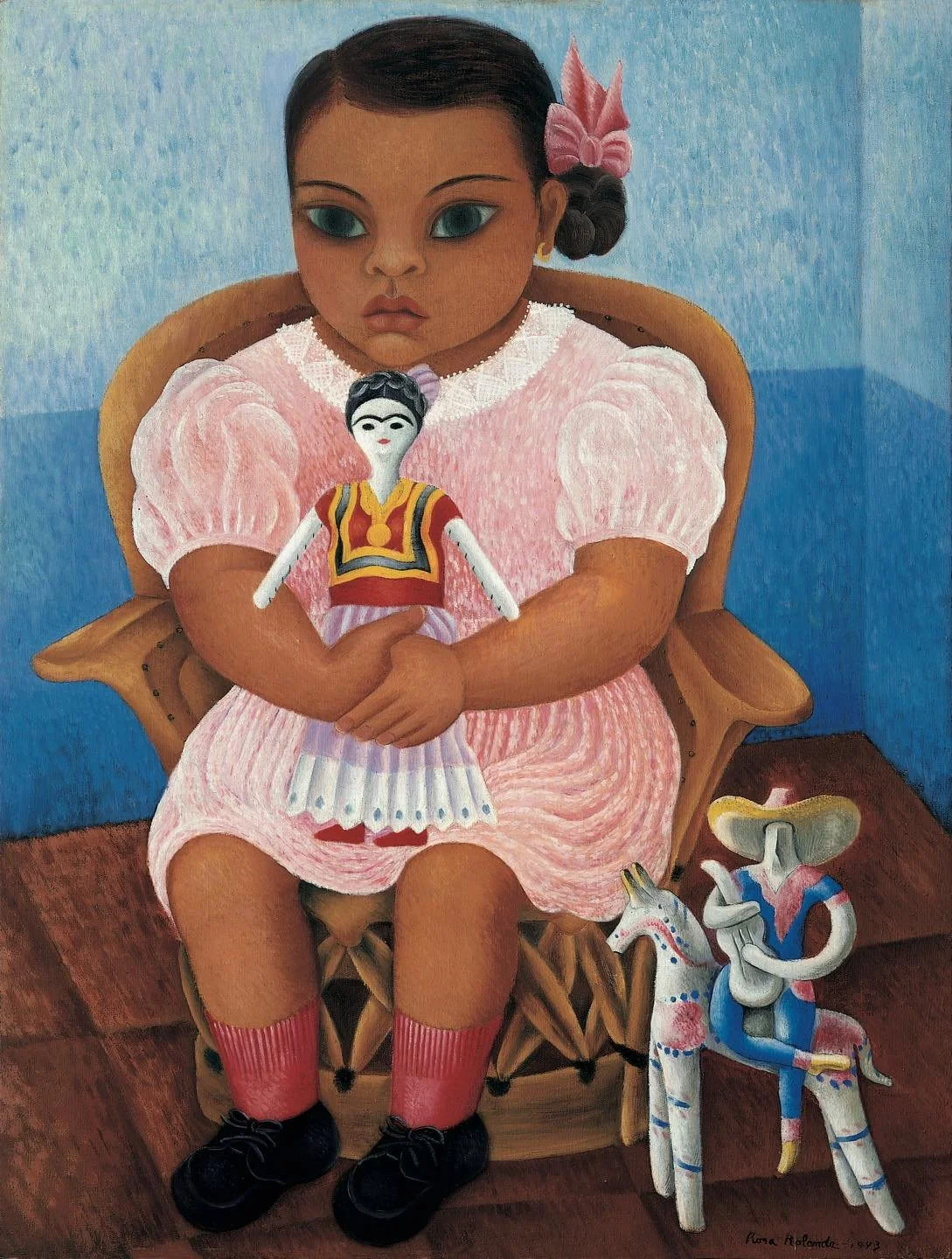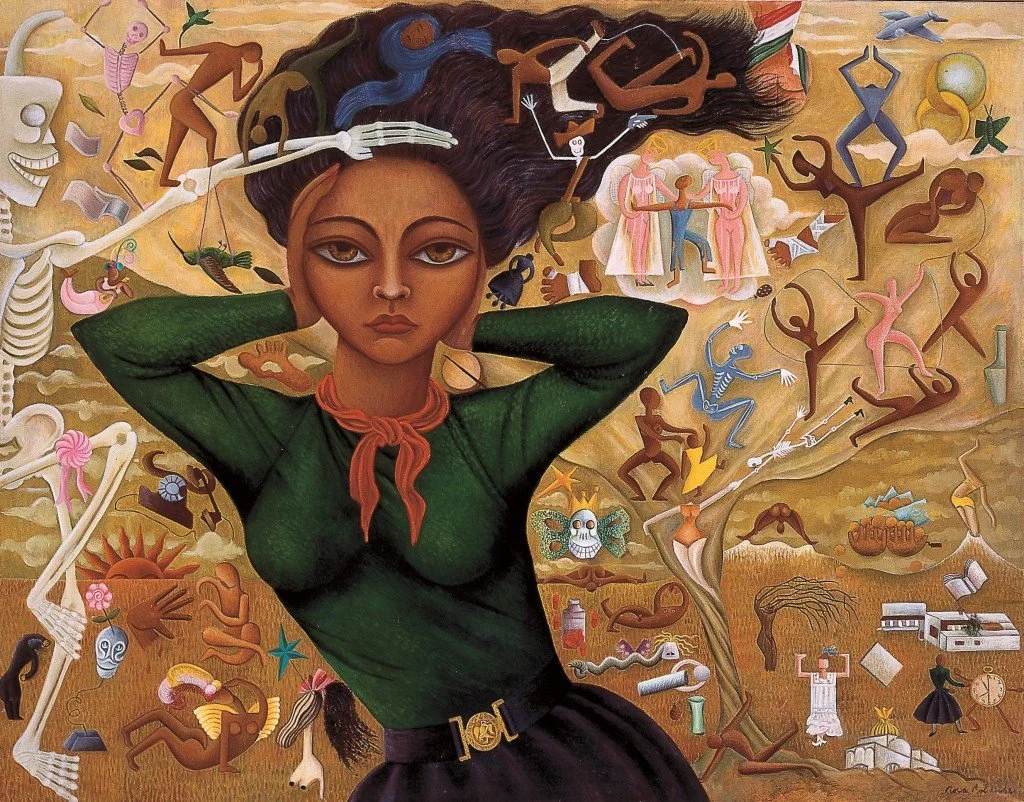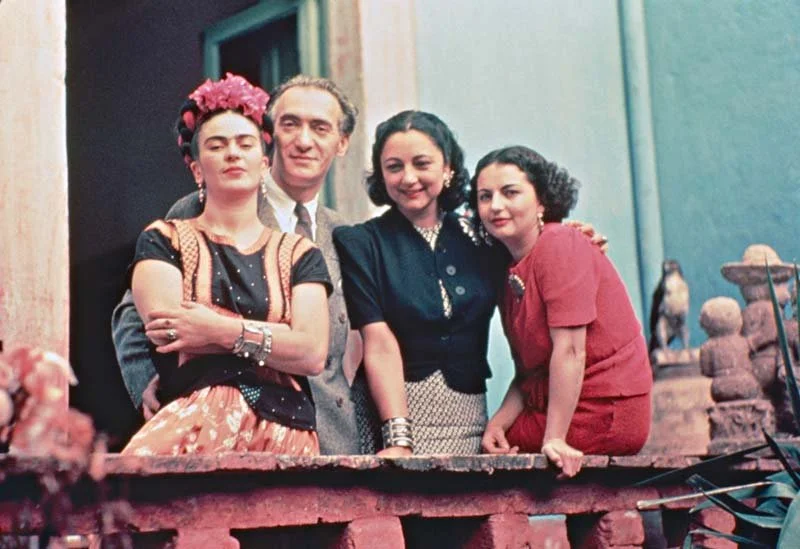36: Rosa Rolanda - from Broadway Dancer to Surrealist
We are back with a dive on multidisciplinary artist Rosa Rolanda!
Chance encounters with her work in the US and Mexico led us to unravel the story of a lifetime, that of Mexico’s first power couple.
Check out the episode below:
For you audio only folks:
You can also listen and/or watch on Spotify
While researching Rosa, it became clear that we could not talk about her work without also discussing her partner and co-collaborator, artist, illustrator, anthropologist Miguel Covarrubias.
Their relationship - romantically and professionally - flourished during a time of explosive creativity in New York City as well as Mexico City.
In our next episode (out next week), with the help of art historian and cultural content creator Veka Duncan, we will dive into Miguel’s work and discuss how his and Rosa’s works are inextricably linked and their place in the Mexican art history canon.
Our discovery of Rosa and Miguel’s story goes back a few years . . . aaaallll the way back to the 2019 exhibit “Frida Kahlo and Arte Popular” at the Museum of Fine Arts in Boston.
There, amongst Frida’s works and personal collection of folk art objects, was “Girl With Doll” from 1943 by Rosa Rolanda in which the little girl is holding a Frida-looking folk toy.
We stopped in our tracks: that little girl looks like a 2000s Bratz doll, the paint strokes and vibrant color palette??? This looked so contemporary (especially the Frida doll!).
On a recent trip to Mexico City, at the Museo de Arte Moderno, we saw what we would later realize is probably her most iconic work “Self-Portrait” from 1952.
Her style had really evolved since “Girl with Doll” and those almond shaped/Bratz doll eyes sparked our memory of that folk art painting back in Boston. We have dozens more figures, some dancing faceless people, skeletons, objects all swept up in an emotional vortex.
Then on a road trip down to Northwest Arkansas, those eyes caught our attention yet again, this time from the walls of the Crystal Bridges Museum of American Art in Bentonville, in “Autorretratro (Self-Portrait)” from 1939 (currently on view at their Foundations of American Art gallery!).
Our interest peaked: this was an artist whose work we came across over the span of 5ish years, each work different, several years apart but there was a through line of experimentation, and them eyes!
Just how our journey discovering bits and pieces of her story through her works, Rosa’ herself slowly began to learn about and fall in love with Mexico, Miguel, hailing from Mexico City, was by her guide. But Mexico was especially dear to her as her mother was from Mexico but we imagine that since she moved to the US as a child, that connection may have been lost.
In this self portrait, we see symbols of Mexican identity like the butterfly or the Aztec-lore volcanoes to her left. The paint strokes are less visible here but still there if you look closely. We like the contemporary illustrative style Rosa takes on around this time - if you didn’t know it, you might think this was painted yesterday.
In our last couple of episodes, we discussed how women artists in the late 19th century fought for equal rights which included wearing looser, non-corseted clothing, like Mary Cassatt envisioned in her mural for the World’s Columbian Exposition.
Detail, Mary Cassatt’s “Modern Woman” mural. Central panel. 1893.
In the early 20th century, years before she became a painter, young Rosa benefitted from those suffragette’s efforts: She found her artistic footing in modern dance which was an outright rejection of ballet’s restrictive style (and often sadistic tbh) instead favoring performing barefoot in relaxed gauzy costumes:
Rosa Rolanda (center) in a still from silent film Blue Bird from 1918
She excelled in dance and her career took off on Broadway, just as the roaring 1920s were ramping up. The US economy was booming and New York City was a hub for the arts - theatre, dance, art and not to mention the Harlem Renaissance (we talk about this more in our upcoming episode about Miguel).
A social butterfly and a lover art and fashion, Rosa soon found herself surrounded by artists, designers, dancers, actors and set designers. This also applied to her dance tour in Paris where she met a one fellow American Man Ray in 1923 who likely taught her how to make photograms which he had rebranded as ‘rayograms’:
Rosa Rolanda, Self-Portrait, ca. 1930, gelatin silver print photogram.
But back in New York City, set designer Mexican artist, illustrator, future anthropologist Miguel Covarrubias’ skills and talent as their passion for the arts led to romance which soon metamorphosed into a lifelong collaboration and adventure.
In the 1930s, they relocated to Mexico and a whole new world opened up for Rosa: not only because of her heritage but because of Miguel, she joined the circle of artists and intellectuals that were shaping modern art - not just in Mexico but also the US. Artists like Frida Kahlo and Diego Rivera and also Edward Weston and Tina Modotti and so many more!
Left to right: Frida Kahlo, Nickolas Muray, Rosa Rolanda, and Cristina Kahlo, c.1930s
Rosa soon learns photography where her experience dancing and posing come in handy. She is able to use these skills in Bali, where she captured intimate moments of Balinese culture in 1936-37.
Over 100 of these works were published alongside Miguel’s illustrations and research in their groundbreaking work, the book “Island of Bali,” which was the first comprehensive account of Balinese culture for the Western world, detailing its art, music, dance, and rituals. It was so acclaimed that it created the first Bali craze and is still referenced to this day.
In her lifetime, Rosa’s painting “Tehuanas” was exhibited in the unprecendented 1940 show “Twenty Centuries of Mexican Art” (co-curated by Miguel) at the Museum of Modern Art in NYC and in 1952 was honored with a solo show at the Galeria Souza in Mexico City, which featured that iconic vortex self portrait.
With her proximity to the biggest names in modern Mexican art, as well as her exploration in so many disciplines, it seriously begs the question: why haven’t more people heard of her, at least in US?
It likely has to do with the fact that she lived most of her life in Mexico and while she was extremely talented and was prolific, she did not consider herself a professional artist: “I paint for pleasure . . . People who see my paintings in my house and like them buy them directly from me”.
However, her fame is resurfacing as she’s recently been exhibited in shows at home and abroad within the last 15 or so years: in 2011, the Museo Diego Rivera y Frida Kahlo held a retrospective featuring hundreds of her works including photographs, drawings, paintings, jewelry and costumes in Mexico City and Puebla.
One of the show’s curators, Diego Rivera’s grandson Juan Coronel Rivera, stated that Rosa Rolanda not being considered a great Mexican artist of the 20th century, with the likes of the great Maria Izquierdo, “was a serious act of omission”.
In 2012, she was featured in the show “In Wonderland: The Surrealist Adventures of Women in Mexico and the United States” at the Los Angeles County Museum of Art and in 2024, The 60th Venice Biennale “Foreigners Everywhere”.
We will leave you with this quote from Rosa, which to us perfectly encapsulates the ethos of her work ethic and her ability to seamlessly embrace any discipline:
“A dancers brain is not in her feet, you’ve gotta think about your work. And what’s more the audience has got to be made to feel what you are thinking. If you are supposed to be . . . a lily swaying in the wind - or any of the things that one might think of, you must behave as anyone of those things would behave.”
We hope you give the episode a listen and/or a gander! If you do, let us know your thoughts!
We are artists and Art Slice is a major part of our studio practice so we appreciate the time you spend with us.
As you know, we make these episodes without the help of researchers, writers (human nor AI), producers, editors, or any staff. We are a lean, mean two-person team, trying to (and oft fail to) balance a regular release schedule with what we view as creatively fulfilling, fun, and substantially worthy of the years these artists themselves put into their own craft.
All that being said, the next episode with art historian Veka Duncan should be out on Nov 4th or 6th, unless we have any work or home life bumps (lol).
The featured song was “Cascades” from the absolutely phenomenal Kris Keogh.
We’ve featured Kris’ work in our Frida Kahlo episode, (https://kriskeogh.bandcamp.com/album/processed-harp-works-volume-1 ) but since then he has released a new album Processed Harp Works, Volume 3 on the Japanese imprint - Muzan Editions.
https://muzaneditions.bandcamp.com/album/processed-harp-works-volume-3
All three of Kris’ Processed Harp Works volumes pit waterfall-like harp textures, processed through subtly glitchy and bouncy rhythms. It’s like drifting off in a meditative trance, being brought back to awareness, before drifting again. If you like artists like The Caretaker - you really need to spend time with these albums.
Other tracks featured:
Elvenheim - “At Night” https://freemusicarchive.org/music/Shamil_Elvenheim/momentum
Holizna - “First Snow” https://holiznacc0.bandcamp.com/album/winter-lo-fi-2
Support the show!
If you haven’t yet, please leave us a 5 star review on your pod player of choice so we can reach new listeners like you!
We would love your support on Patreon as those funds help support our research in the form of books and travel (it makes our visit to see some of these works in person possible!).
You can also support us by purchasing some merch!
Thank you to our lovely Patrons and those of you who have purchased merch from us in the past few months - it means so much to us! We know your time and money is a precious resource and we are so grateful for every bit of it.










